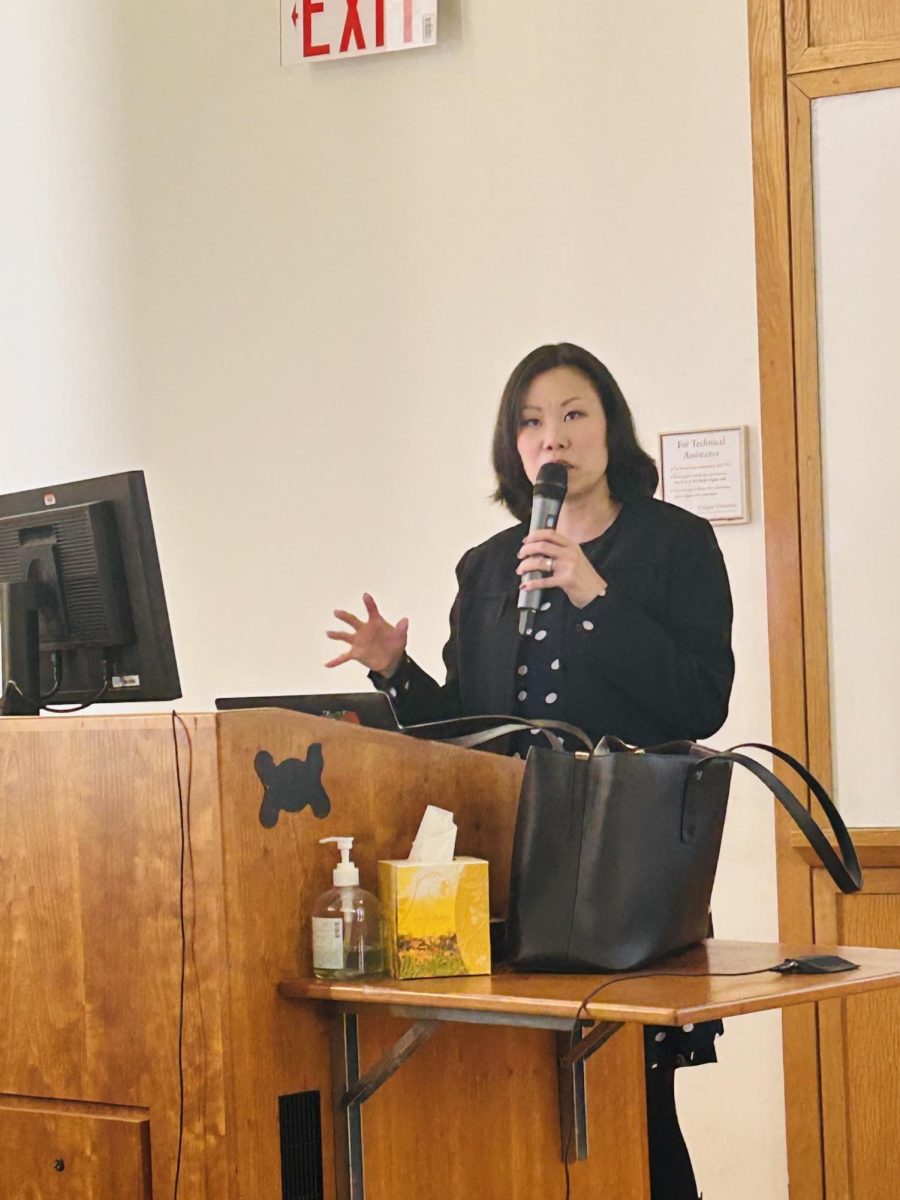Colgate University welcomed alumnus and Associate Professor of Philosophy and Co-Director of the Institute for Philosophy and the New Humanities Zed Adams ’96 from the New School for Social Research. Adams discussed the relationship between language and perception on Thursday, Nov. 2, and spoke on several theories regarding how basic color terms of different languages affect the perception of color.
Adams was inspired to pursue this topic in his senior year of high school, where he was introduced to the 1960 novel “Les Bouts de Bois de Dieu,” meaning “God’s Bits of Wood,” by Senegalese author Ousmane Sembène.
“My teacher suggested that there was something unfortunate about Ousmane having written the novel in French. French, after all, is not the language that Ousmane grew up speaking. His first language was Wolof, a West African language spoken in Senegal, Mauritania and Gambia,” Adams said. “French was imposed upon him as a teenager at the colonial school he attended. My teacher proposed that this imposition of French constrained Ousmane’s ability to express his own experiences in writing […]. There seemed to be some kind of fundamental incompatibility between these two languages.”
Adams continued to explore this concept through the lens of color perception. Analyzing a comparative chart of basic color words across different languages, Adams noted that some languages, like Russian, have a dozen basic terms, whereas others, like Berinmo, have only five. English itself has 11: black, white, red, orange, yellow, green, blue, purple, pink, brown and gray. He proposed three possible interpretations and delineated the studies that either supported or refuted each interpretation.
“The first interpretation you might have in response to this list is to think that there’s a kind of concept blindness that occurs when you lack a word in the language you speak, where the lack of word is evidence for the lack of a concept,” Adams said.
However, Adams noted how American psychologist Robert S. Woodworth found this proposition to be incorrect.
“Woodworth found that even among the people who lacked words for blue and orange, they were just as adept at matching pairs, including blue and orange pairs, as speakers of languages that had those words,” Adams said.
Adams used Woodworth’s conclusions to summarize this finding.
“‘On the whole, color sense is probably very much the same all over the world,’” Adams said, quoting Woodworth.
Speakers of different languages can all distinguish between different wavelengths of colors to the same ability. All people, therefore, see the color gradation in essentially the same way.
According to a second interpretation, the difference lies in how individuals group together various colors.
“Languages arbitrarily set boundaries on the color spectrum. Language is imposing a kind of structure on the color system that wouldn’t be there otherwise,” Adams said. “Linguistic relativism is the idea that color categories depend upon linguistic categories, that it is the existence of these linguistic categories leading people to perceptually divide up that visual spectrum in the way that they do.”
Yet again, the research found that strong linguistic relativism is absent in inter-linguistic studies.
“The conclusions that Rosh drew from her study were first that color categories don’t depend upon linguistic categories — that color categories are universal,” Adams said. “They’re independent of language, and — really interestingly — she concluded that the color categories are better understood in terms of color foci.”
A third and final interpretation states that weak linguistic relativism, in which language merely influences but does not define color categories, is responsible for linguistic differences.
This theory was supported by three studies but was outshined by a final study, which found that distinctions between color predate language in toddlers.
“Words are less important for thinking about color than we might think, and that should be surprising […]. The color categories are universal,” Adams said.
Adams then applied the philosophical implications of these conclusions to a universal view of language, returning to the initial question of the author Ousmane Sembène’s capabilities of writing in a language other than his first.
“Whereas my French teacher seemed to think that this colonial language of French was like a prison, trapping Ousmane in his ability to communicate his own experience, I don’t think that’s right,” Adams said.“I think it would be better thought of as a kind of prism — something that can enhance our ability to distinguish things, like a prism does to white light, but not something that constrains what we think or express.”
This lecture proved to be thought-provoking for its student audience. Junior Barry Regan contemplated the implications of Adams’ conclusions on the human experience.
“I’m very interested in how perception works, especially when it comes to human emotions,” Regan said. “The interplay of how we describe human emotions with colors is really heavily relevant [on] this […]. I think a lot of perception is purely based on language, because once you learn to think in your head, you learn to perceive in a proper way. That affects how we view the colors, and that affects how we view our own emotions. So I think this was a really great insight on the interplay between language and perception.”
Colgate’s department of philosophy felt fortunate to welcome Adams back to campus. Professor and Richard J. and Joan Head Chair in Philosophy David McCabe praised Adams’ work as a creative and academic individual.
“I thought [Adams] did a great job of laying out the central issues in the debate over the extent to which a community’s available concepts and language shape our perception of the world,” McCabe said. “And it was especially great to bring back to Colgate one of our own alums — just one of several from the philosophy department who have gone on to flourishing careers in the field.”
















